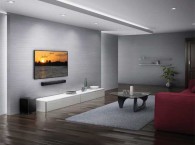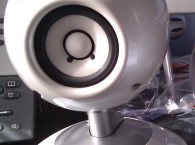Thiel Audio’s New CS1.7

Photo 1: Thiel Audio CS1.7
Thiel Audio recently launched its first new product since the company was acquired last year by a Nashville, TN-based equity company. The product, designed prior to the acquisition, is the company’s new CS1.7 two-way tower design priced at $3,999. The speaker uses 1” MDF on all walls except the front baffle, which is 2” thick (see Photo 1).

Photo 2: Niles Audio Cynema Soundfield
Niles Audio Offers New Soundbars
Niles Audio recently launched a new series of horizontal in-wall soundbars (see Photo 2). The Cynema Soundfield systems are the first of this specific type of product to be offered in consumer electronics. The four systems comprise one passive model and three active models in 48”, 55”, and 65” widths. The passive CSF-48P model costs $1,195, and the active models (the CSF-48A, the CSF-55A, and the CSF-65A) cost $1,599, $1,749, and $1,999, respectively. All of them are left-center-right (LCR)-type soundbars.
The Cynema soundbars’ modular design accommodates in-wall installation without having to cut wall studs to make room for the speaker. Instead, installers mount a horizontal rail onto the wall studs, and then snap the speaker and amplifier modules into the rail. Installers move the modules left or right through an opening in the wall to position them between the studs and align the speaker modules with a wall-mount TV.
The powered models include a separate low-voltage power supply that mounts to a stud next to a wall outlet or behind the display. The low-voltage power supply eliminates the need to run new high-voltage wiring in the wall, eliminating the need for a licensed electrician. The powered models come with 3 × 30-W preamp/amplifier with Dolby Digital processing. The module turns on via IR remote or via an audio-signal-sensing input that turns the soundbar on when its audio input senses audio signal. The in-wall soundbars also integrate with whole-house distributed-audio systems and connect wirelessly to Niles subwoofers.

Photo 3: Mike Detmer
Detmer Launches New Company
Industry veteran Mike “Sparky” Detmer, former president of Niles Audio, has launched a new company offering strategic planning and business-optimization services to manufacturers, distributors, and dealers in the technology-integration and consumer electronics industries (see Photo 3). His new company, Mike Detmer Business Solutions, offers business-optimization services (e.g., business planning, sales-force optimization, training, marketing coordination and budgeting, product management, portfolio planning, and demand planning and coordination).
For more information, visit mikedetmer.com, e-mail mdetmer@mikedetmer.com, or call (305) 798-8510.
MISCO Partners with Digital Audio Labs
MISCO (Minneapolis Speaker Company) recently partnered with Digital Audio Labs (DAL). MISCO and DAL share two key passions: creating great sound systems and meeting customer needs by delivering the exact sound they want. MISCO and DAL complement each other, effectively anchoring the middle and end of the signal chain. DAL is the expert in amplification and digital audio processing. MISCO’s expertise is in loudspeaker design and manufacturing to fit the specific audio needs of a variety of industries, including pro-sound, home audio, musical instruments, medical, aerospace, and military.
Like MISCO, DAL brings its own long track record of innovation to the partnership. DAL rolled out its first audio interface in the late 1980s, when digital audio was still in its infancy. It went on to develop audio interfaces (e.g., CardD and CardDeluxe—the standard in broadcast and measurement markets). Today, DAL provides expertise in digital signal processing, A/D and D/A conversion, amplification, and manufacturing.

Photo 4: Misco PowerShape 2.1
DAL’s most interesting new product related to the MISCO partnership is the PowerShape line of integrated Class-D amplifiers. The key benefit of PowerShape amps are their simplicity—integrating input, signal processing, mixing, and amplification into one box. PowerShape currently comes in two models. PowerShape 2.1 is a cost-effective solution for small-to-midsize installations such as classrooms and corporate conference rooms (see Photo 4). It features digital or analog inputs, stereo or 2.1 output, along with DSP and mixing controls that include gain, five-band EQ, compression, and crossover. It’s easily configurable over Ethernet, USB, or RS-232.
PowerShape 8 is the “audio workhorse,” designed for medium-to-large installations with multiple speakers or zones. It features 12 inputs with DSP on all channels, a 12 × 10 matrix mixer, four-band EQ, compression, and crossover. It also delivers eight, crystal-clear 50-W Class-D output channels.

Photo 5: Misco product concept
Working with digital audio enables DAL to shape the sound audio engineers and OEMs want to achieve, a job that’s completed in the analog realm by pairing DAL electronics with the right MISCO speakers. DAL calls its proprietary DSP algorithms “building blocks” in the signal chain. These algorithms give the customer finely tuned control over parameters (e.g., EQ, compression, and crossover). Now, it’s easy for individual engineers to easily customize, control, and adjust the signal chain to get their desired sound or effect. By working together, MISCO is now able to offer complete, stock, and customized audio systems for gaming, kiosks, digital signage, medical applications and a list of other commercial and industrial sound applications (see Photo 5). For more information about turnkey systems using DAL electronics and MISCO speakers, contact MISCO President Dan Degre at (612) 825-1010 or visit www.miscospeakers.com.
Audit Confirms CEA Show Statistics
The Consumer Electronics Association (CEA) said an independent audit confirmed that 152,759 people attended the show in Las Vegas, NV, in January, 2013. Also, a record 36,206 international industry professionals from 150 countries attended the show. The 2013 CES featured 3,282 exhibitors, including a record number of startup companies, located on more than 1.92 million net square feet of exhibit space.
The Veris audit confirmed that 43% of 2013 CES attendees were senior-level executives. Presidents, CEOs, and business owners made up 15% of attendees. Nearly one-third of all attendees are the final decision makers when it comes to new product purchases or partnerships with other companies, with 84% of them identified as having buying decision influence. More than 11,000 attendees represented companies with more than $500 million in total annual sales. More than 13,000 retail-buying organizations, 8,000 manufacturers, and nearly 6,000 engineering/research and development companies came to the 2013 CES. Additionally, more than 32,000 professionals from the content development and entertainment industry were in attendance, as part of the Entertainment Matters program, providing entertainment executives the chance to experience the latest devices, technologies, and platforms that will broadcast content to the consumer.
Congress Considers Patent Legislation
Given the increase in patent lawsuits being filed against inventors and manufacturers, the US Senate is considering new patent legislation. Gary Shapiro, CEA president and CEO, released the following the introduction of the proposed Patent Quality Improvement Act of 2013:
“We applaud Senator [Charles E.] Schumer for introducing legislation that promises to make it easier for companies to fight back against frivolous lawsuits by so-called Patent Assertion Entities (PAEs or patent trolls). Patent litigation abuse has reached a crisis level—innovators, businesses of all sizes, and even individual end users are being targeted by firms that do not produce anything, but simply exist to bring lawsuits. In effect, trolls have hijacked our patent system—they now account for the majority of patent litigation in the US, at the cost of tens of billions of dollars to our economy and to American consumers. By enabling defendants to seek review of a patent’s validity, the bill creates a quick cost-effective alternative to litigation. Without having to face the immediate potential of millions of dollars in legal fees, companies targeted by trolls will face less pressure to pay money to resolve frivolous lawsuits. In combination with other measures like the SHIELD Act, the Patent Quality Improvement Act will help drive patent trolls back under the bridge and allow our innovative economy to move forward.”
SuperCube2000 Recall
Definitive Technology has voluntarily recalled its SuperCube2000 powered subwoofers built in September 2012 because of a potential shock hazard, according to a U.S. Consumer Product Safety Commission (CPSC) announcement. About 900 units with serial numbers containing the characters 0912HB are covered by the recall. According to the CPSC, Definitive has received two reports of consumers who were shocked while handling the unit. For its part, Definitive said on its website that in some units built last September, “an improperly installed internal lead could cause 120-V current at the connections on the back panel of the subwoofer, potentially causing an electric shock if the connecter is touched while the unit is powered.” Definitive recommends that consumers who bought a SuperCube2000 after November 1, 2012, unplug the subwoofer AC cord at the wall, check the serial number, and immediately discontinue the use of any SuperCube2000 subwoofers with the letters “HB” in the serial number. The Chinese-made subwoofer was sold at electronics stores nationwide and online at Best Buy and Amazon between November 2012 and January 2013 for about $600.
Home Technology Market Remains Stable
The home technology market’s overall growth remained consistent from 2011 to 2012, demonstrating its strong, stable foothold, according to new findings in the 11th Annual State of the Builder Technology Market Study released today by the Consumer Electronics Association (CEA). Technology installations in new homes reached or exceeded 2008 levels, providing more evidence that the market for built-in home technologies is recovering. Structured wiring remains the most common installed technology (70%), followed by monitored security (44%), and home theater pre-wire systems (27%)
Home technologies have become valuable marketing tools for new homes. Builders say marketing these technologies is important; close to half of builders surveyed (49%) said they find it much more or somewhat more important to market these technologies today. Builders increasingly work with home technology experts, including electricians, security installers, custom installers, and electronic systems contractors. Builders reported that they were most satisfied with electrical (79%), security installer (77%), system integration (75%), and electronic system (66%) contractors. The primary factors driving builder decisions to work with installation service providers remain price (80%), reputation (75%), completeness of offerings (73%), and prior experience (71%).
Overall, builders report installing popular technologies like structured wiring and monitored security in remolding projects. Small builders (42%) saw a greater revenue portion from remodeling efforts in comparison to luxury homebuilders and local builders. The study also finds that almost all (92%) new homes are equipped with broadband cable, up 36% from 2002. With greater broadband access, the report notes that in 2012, one in four newly built homes (23%) have a dedicated home theater room as opposed to one in 10 in 2010.
The 11th Annual State of the Builder Technology Market Study comes as CEA and HGTV announced their partnership, building the first-ever high-tech home in Jacksonville Beach, FL. Using CEA’s TechHome Rating System (THRS), HGTV built the Smart Home 2013 to meet the THRS’s gold specifications for technology infrastructure. The gold rating provides a whole-house network that distributes audio, video, data, telephone, television, home automation, and security signals into multiple rooms. VC






